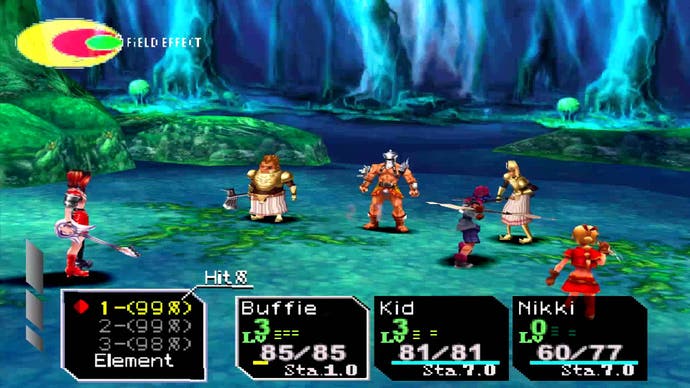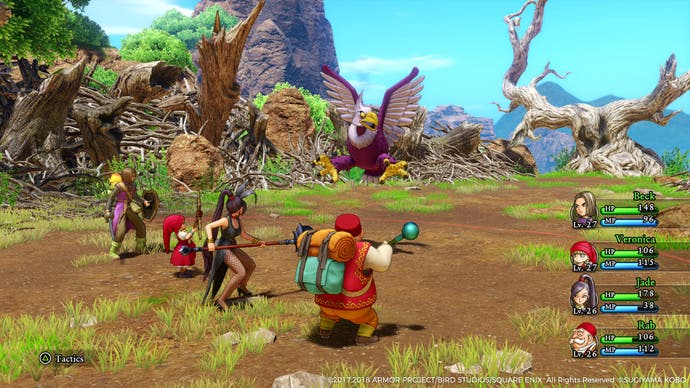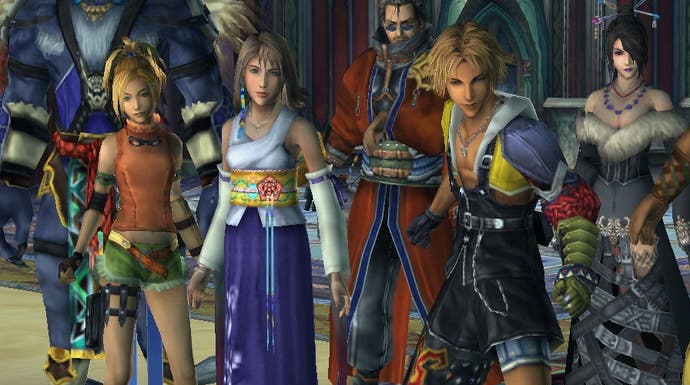How is a battle system like a poem?
Active Rhyme.
I've been fascinated lately by micro-RPGs, and specifically micro-JRPGs. Typically crafted in RPG Maker and published on Itch.io, these clever miniatures run a wide gamut, as I learned from a Twitter chat with sraëka-lillian, creator of the experimental OI series. Some, like GeaSaga from Ka·in Works, are full-scale distillations of classic role-playing narrative structures, trimming back all the grinding, exposition and angst to a limber playlength of 10 hours or less. Others snip off and spotlight cherished pieces of those larger games, like slimes or fishing - I'd love to play one dedicated to the act of Getting The Airship, or a demo compilation of Sleepy Starting Villages. Micro-JRPGs are often funny or parodic - there's a certain, baked-in whimsy to the thought of a role-playing game you can polish off in an evening - but they can also be earnest and melancholy. Facets from Far Away Times, for example, is a series of boss dungeons that form a harrowing story about erasing somebody's personality.
Whatever their tone or focus, micro-RPGs show that miniaturisation in itself can be a kind of critique. In shrinking the playtime, they concentrate and reveal things about the games they riff on that are hard to visualise when you're trudging through the second act of a hundred hour adventure. In particular, they've gotten me thinking afresh about one of my great passions, the grandly staged and rulebound combat encounters of JRPGs from the PS1 era and before, and how these antique yet enduring fixtures suggest a different, healthier way of engaging with the games I identified in a recent article as morbid exercises in busywork and scale. In presenting themselves as separate structures - martial dioramas, sealed off from exploration and the narrative behind loading breaks, with their own scenery and soundtracks - these skirmishes invite a reading of their games not as over-inflated sagas or scenic hikes spoiled by the presence of a million Giant Rat reskins, but as collections of combative, poetical devices that come alive in the repetition.

To illustrate that, here's a micro-review of Cataphract OI, sraëka-lillian's latest project and one of my games of last year. Cataphract's setting is caught in yet another videogame timeloop; fail, and the SNES-era world map melts and rebuilds itself like a sandcastle emerging from the sea. The Red Star Cohort, a trio of crack mercenaries, must break the cycle by escorting a mage called the Supplicant to the heart of a strange fortress. Helpfully, they've has left this to the evening before the loop resets. Every action, in or out of battle, advances the clock, so it's just as well that navigation is so brisk. Pick a compass heading and your party scampers from room to room, fanning out automatically in a pleasing, understated kind of characterisation - the Satellite, your tank, is rarely far from the Supplicant's elbow.
To make it to the centre you must scour each screenful of masonry for keys to coloured doors, always at the risk of discovering nothing and burning precious seconds. And of course, you must fight: the fortress is full of undead. Battle looks generic at first: a line of static sprites waiting to be bowled over like coconuts at a fairground; old school class abilities ranging from mana transference to instakill banishments; turn order determined by character initiative. But there is something powerfully bizarre at the heart of it all, and that is the Fray.
The Fray isn't just another word, here, for people fighting. It lies somewhere between a quality, an entity and a point in space. Party members and enemies are essentially invincible when they're not in the Fray, so you must use special actions to place your adversaries inside it, while keeping your own fighters and the Supplicant out of danger. Which makes the Fray sound like No Man's Land - one of the enemies has the ability to "circle around", manoeuvring your party into the killzone. But it also, confusingly, functions like a status effect such as poison: you can "engage" an enemy, driving them into the Fray, without, counter-intuitively, falling into the Fray yourself. The ideal scenario, in fact, is for all of your enemies to all be in the Fray while your party members somehow remain outside it.
Rather than a specific location or the clash of blades, the Fray emblematises the possibility of change, for better and worse. Forcing somebody inside it is like lifting the lid on Schrodinger's Cat. As such, it's the unspoken crux of a story concerned with averting the repetition of the same - a theme Cataphract OI pursues at the level of both writing and fighting. The game's Read-Me calls the Fray a "vortex" - a word that, I was delighted to discover, stems from the Latin "vertere", meaning "turn". Cataphract OI is about "turning" in several, nested senses - turning as transformation, as the taking of turns in battle, and as turning back the clock, restarting the loop. Victory is about turning your enemies while avoiding being turned yourself, so that you can stop the world from turning - so that it can turn into something new.
Battles, here, aren't just routine obstacles that must be laboriously overcome to follow a plot and rinse the geography of objectives and rewards. They are twisty, poetic microcosms for a narrative that is itself a work of spiralling theatrical machinery. To repeat the encounter is to unwind the larger concepts at stake, to tease out the implications of “turning” as though slowly deciphering a phrase. I call this "poetic" because turns are rather important to poems, too. "Vertere" is also one of the etymological origin points for "verse", as in the turning of a traditional line of poetry, zig-zagging down the page. And this turning-back is another kind of turning-as-transformation: the line resets to the left-hand margin, but the poem as a whole evolves, its imagery and senses expanding, descending towards a conclusion - the end of a poem being the point at which, for whatever reason, no further turns are possible.
Am I giving you a headache? Suffice it to say that Cataphract OI's nested puns are a reminder that poetry, much like the classic JRPG, is an artform concerned with alteration and recurrence, with overt and ornate patterns and rituals that facilitate the development of an idea or story. In less inspired hands, those rituals can be as monotonous as defeating the same three enemy types with the same three-move elemental combo for hours on end. But at their most engaging, poems and RPGs like Cataphract OI also reframe repetition as something resonant and playful rather than suffocating, an opportunity for either elegant synchronicity or surprising discord in the service of a larger idea or feeling, rather than just one thing after another.
The best-known flavours of repetition in traditional English language poems are rhyming and metre, aka the number of syllables or stresses in a single line. There are also "stanzas", from the Latin for “stopping place”, which refer to a chunk of lines governed by a particular rhyme scheme. Repetition in poetry has served many purposes through the ages. For one, it makes poems easier to memorise and pass around, which was pretty crucial back before mass printing methods when a lot of people were unable to write or read (by analogy, think of how quickly a JRPG's reward screen music gets stuck in your head). But the prospect I want to explore here is that when you're working to an explicit formula, you can excite or intrigue your audience by bending or breaking the rules.
It's a recipe for tension and contrast. The tension between the length of a poetic line and the length of a sentence or clause, for example - should the turn of a line correspond neatly to a grammatically complete statement, or should the sentences overrun lines in an "uninhibited" gush of feeling? Or the ironic contrast between one word and the word it's rhymed with. As a reader, it's fun to watch a talented poet navigate this sphere of competing energies, like Milton's Satan crossing the void between Hell and Earth - cleaving skilfully to the patterns at times, going a little or entirely AWOL at others.
This compares, I think, to the experience of getting your head around a battle system in classic JRPGs - learning to live inside their unwieldy parameters as you embark on a journey that is as much about grasping and developing the ideas and sentiments intrinsic to the cycling structure of every encounter as it is navigating a landmass, or thwarting some arch-nemesis. Games like Dragon Quest aren't, of course, unique in being cyclical - turns and returns abound in genres of all stripes, from Halo's endlessly rewound 30-seconds-of-fun to the recent glut of timeloop stories. But few other genres make such a spectacle of this, as Final Fantasy 9 reminds us by conducting its opening battles on an actual stage. There's no minimising of the clockwork, as in auteur blockbusters that regard “illusion-breaking” HUD tricks with heavy disdain. With their cutaway cinematics and title cards, special gauges and turn order bars, JRPGs want you to revel in the battle system as an explicit form. One pay-off is that repeating the form becomes a kind of celebration, or at least a more obvious kind of celebration - not just an enjoyable thing you do to progress, but a kind of spell you cast on yourself and the game, where playing with the repetitive elements is part of the magic. In more experimental works such as Cataphract OI, it can also become the excavation of a theme.

We often call RPGs "epics" - a word that fills jaded middle-aged me with exhaustion, but that's before I remember that "epics" were originally long narrative poems, buoyed up and borne along by humming loops of rhyme and metre that can be tuned or mistuned to sparkling effect. Battles in classic JRPGs are perhaps better understood as stanzas. They are separately loading "stopping places" with their own fixtures, soundtracks and pocket narratives of brilliance and miscalculation, risk and reversal.
Much as the individual metrical effects of epic poems reflect a larger strategy, so battles are tethered to the world beyond the arena in how they elaborate characters and themes. Combat chemistry is also emotional chemistry: party members generally function together as playing pieces in ways that agree with the development of their personalities, their romances and rivalries, their goals and revelations. Or which don't quite agree with them with them in fun or illuminating ways: I have always enjoyed the fact that Bernadetta from Fire Emblem: Three Houses is both a frantic homebody who prefers to chat through her bedroom door and an absolutely vicious sniper.
Much as your sense of how people fight colours your response to them in cutscenes, so the progress of the wider narrative slowly alters the story of each battle in the form both of scripted lategame shifts such as “ultimate ability” unlocks, and more organically in who you have do what, depending on the dramatic stakes. If the scenario is a grudge match between your glass cannon wizard and his long-lost evil sister or whatever, it's only right and satisfying to offer that wizard the decisive blow, even if it means wasting a turn reviving him and risking a disastrous setback. Or perhaps you'd rather he didn't get his hands dirty because after all, blood is thicker than XP. Sometimes, of course, you just want to give your favourites the limelight: when I play Final Fantasy X I have Lulu perform all the coolest takedowns regardless of the situation, because good heavens, just look at her. What kind of philistine hands a wet turnip like Wakka the snazziest finishers when you've got Spira's own Morticia Addams lounging on your party screen?
Going into battle is about participating in this telling, retelling and mistelling of who your people are. As with the rules of versification, the rules gradually cease to be tiring constraints and become things you compose with, cleave to or break away from. Battle in the JRPG is a supple poetic incantation, a kind of meta-summoning rite within specially prepared and porous chambers - and far from just a source of meaningless padding, the element of repetition is key.

Formal parallels like these are part of the reason so many poets have become interested in videogames - not just as things to write about, but as bodies of exotic, generative rules that are as vivid on the page as they are on the screen. Look at Jon Stone's "ludokinetic" poetry or Calum Rodger's chapbook Fiat Ontology, which navigates a kinship between the seasons of Proteus and various types of experimental verse. Or how about Maria Sledmere's arch revising of the Chao Gardens from Sonic Adventure, published in the recent Hit Points anthology from Broken Sleep Books.
Assuming you're convinced by any of this, what other tedious, recurring structures in games could we redefine as exciting, poemy contraptions? One prop I've never missed an opportunity to dump on recently is the open world tower: a vertical puzzle, mapping tool and means of synchronising player with character, whose charm has been dulled by ubiquity. I associate towers nowadays with at best, another map region I can't be bothered to 100%, and at worst, a type of production that seems inextricable from crunch. But the other day I stumbled on Henry Johns' poetry chapbook A warm day in spring, a sequence of tower views that each use the same rough phrase structure - the repeated absence of a gravestone forming another strange vortex at the heart of each perspective. And I think to myself: perhaps the problem with towers is that I've forgotten how to make them rhyme.









